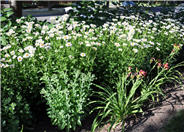
Common name:Becky Shasta Daisy
Botanical name:Leucanthemum x superbum 'Becky'
Becky daisy is larger than most other Shasta cultivars, growing 3 to 4 feet tall on rigid stems which do not require staking. Flowers are 3 to 4 inches across, with the classic white rays and yellow centers, and coarsely-toothed, lance-shaped, medium green leaves. Stems do not require staking. Long bloom period of July through September. Excellent and long-lasting fresh cut flower. Not a low-water perennial, but certainly a fine addition to a perennial border that receives regular watering. Grows 3 to 4 feet tall and 2 to 3 feet wide.
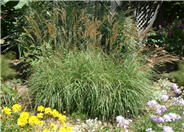
Common name:Japanese Silver Grass, Maiden grass
Botanical name:Miscanthus sinensis
Miscanthus is a large group of ornamental grasses ranging from a few feet to over 7 or 8 feet tall. Blade colors range from solid green, to green with silver mid-ribs, to variegated forms. Plumes are generally held well above foliage clumps, appearing in late summer to early fall, depending on the variety, and may be cut for fresh or dry arrangements.
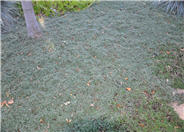
Common name:Woolly Thyme
Botanical name:Thymus lanuginosus
Woolly Thyme is a perennial groundcover growing in a low mat, typically under 2 inches, but spreading 16 inches or more. Foliage is fuzzy and gray-green during the summer months, and tinged with a lovely burgundy hue in the fall and winter. An evergreen thyme, it makes a wonderful groundcover, even an alternative to turf, in low traffic areas. And as it tolerates some foot traffic, its wonderful between pavers and along pathways. It has a pink summer bloom, though it rarely flowers; the lovely fall color fills the void.
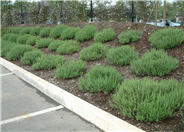
Common name:Wall Germander
Botanical name:Teucrium chamaedrys
Wall germander is a shrubby, woody-based, clump-forming, broad leaf evergreen, grown for its attractive, aromatic, semi-evergreen foliage. Tiny, oval, scalloped, shiny dark green leaves densely cover numerous ascending and spreading stems which collectively form a mound of foliage about 12 to 15 inches tall and wide. Leaves resemble miniature oak leaves (chamaedrys means "ground oak" in reference to the leaf shape and ground cover habit). Whorls of two lipped, tubular, pink to purple (less frequently white) flowers (typical mint family) appear in terminal clusters in late spring to early summer. Use it to edge a sunny border, to line walks, or in a sunny place where you want something "boxwood-like." A very old plant, it has commonly been used in herb and knot gardens for hundreds of years.
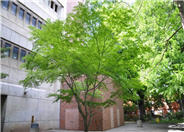
Common name:Honeylocust
Botanical name:Gleditsia triacanthos var. inermis
Honeylocust are prized for their fine-textured leaves that provide a pleasant, dappled shade. Generally with light green leaves; some cultivars have yellow spring growth. Open and spreading crown makes for a fine shade tree. Bark is a greyish-brown and furrowed. sizes range from 25 to 50 feet or more, with a spread generally less than the height. Golden yellow fall color and open winter silhouette provides attractive fall and winter appearance. Deciduous.
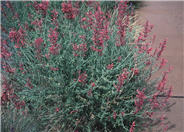
Common name:Licorice Hyssop
Botanical name:Agastache rupestris
Enjoyed for its fine, aromatic foliage and uniquely colored flowers, this is an excellent addition to a water-wise garden. Pale grey-green leaves are licorice scented and grow along stiff, upright stems, topped with orange and lavender flowers that bloom mid to late summer. Attractive to hummingbirds, butterflies, and bumblebees. Dead head for best flowering. It is native to mountain regions of Arizona, New Mexico and Northern Mexico.
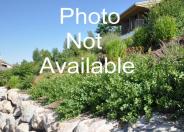
Common name:Bluebell-of-Scotland; Harebell
Botanical name:Campanula rotundifolia
Don't let this perennial's delicate appearance fool you; Bluebell-of-Scotland is one tough little flower. Foliage is a soft green, and creeps and trails in a ground-hugging mat; flowers stand on erect, wiry stems maybe about 12 inches high. Violet blue and bell-shaped blooms appear in mid to late summer. Enjoyed by native bees and bumblebees. Use along a pathway, in a parkstrip, or to edge a perennial or shrub border. It has a charming habit of weaving in and around larger perennials and shrubs.
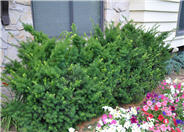
Common name:Dense Spreading Yew
Botanical name:Taxus x media 'Densiformis'
'Dense' is a useful evergreen for the average or smallish urban landscapes, as it as a low, spreading habit and grows about 3 to 4 feet tall and 4 to 6 feet wide. Branches are upright and arching, creating nice vertical to horizontal lines. New growth is bright green, maturing to a dark green. Berries are bright red, but are not suitable for human consumption. Use at the foundation or in a shady shrub border or hedge to provide winter interest.
| Designer: | Misc 41 |
Photographer: GardenSoft |
Water Saving Tip:
Group plants in your garden according to their water needs (hydrozone).
